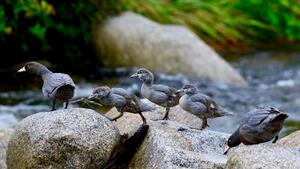Satellite imagery, AI and genetic technologies have the potential to help boost Aotearoa New Zealand’s biodiversity, according to a new briefing we jointly published yesterday.
We partnered with the Department of Conservation Te Papa Atawhai (DOC) to develop a Long-term Insights Briefing (LTIB) that explores how we can help biodiversity thrive through the innovative use of information and emerging technologies.
Read the final version of the LTIB which is available on DOC’s website.

Whio family in Katipo Creek, Heaphy Track (DOC Crown copyright)
LTIBs are think pieces designed to provide information on medium- and long-term trends, promote public debate and inform future decision-making on the risks and opportunities affecting Aotearoa New Zealand. They are not government policy and are developed independently of Ministers.
We worked jointly with DOC on this topic because we both have roles and responsibilities for biodiversity protection on Crown land. The topic was chosen because innovative technologies present opportunities to help stop and possibly address the biodiversity crisis facing Aotearoa New Zealand.
The LTIB highlights three areas of transformation that have particular promise for biodiversity conservation:
- satellite imagery and remote sensing, for improved environmental monitoring and surveillance
- AI and data-driven technologies, for collecting and analysing large quantities of data
- genetic technologies, for new types of environmental monitoring and management.
Click here to read more about the LTIB and its creation, including consultation, engagement and key research. Questions and feedback can be emailed to ltib@linz.govt.nz or ltib@doc.govt.nz
Media contact
Email: media@linz.govt.nz